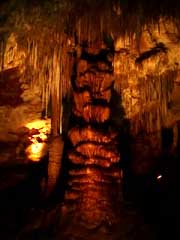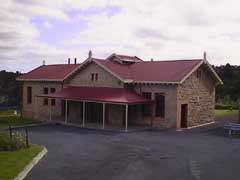
Mount Gambier, SA
Saturday 7 - Sunday 8 Nov 1998
[Previous]
[Next]
[Bottom of Page]
[Index]
[HOME]
Saturday 7th
It was raining this morning so we decided to press on to Mount Gambier.
On the road to Millicent we passed one of the local oddities, Woakwine Cutting. In 1957, a farmer by the name of McCourt decided to drain the swamp which occupied part of his land. He set about making a cutting through the hills between his land and the nearest lake. With the help of one other man and using explosives and a D7 caterpillar tractor dragging a bucket scraper, he cut a channel about 3 metres (10 feet) wide at the bottom, 20 to 30 metres (60 to 100 feet) wide at the top, and about 1 kilometre (1100 yards) long. This required the removal of 276,000 cubic metres (360,000 cubic yards) of rock and took the two of them three years. This has to rate up there in your top ten demonstrations of sheer bloody-minded tenacity.
We booked into a beautiful caravan park on the top of Mount Gambier and took a drive round the crater lakes which are the centre of Mount Gambier. The biggest is Blue Lake which is the local water supply and can only be seen from lookouts on the crater rim. It is quite stunning with the geology of the volcano eruption which took place withing the last 10,000 years very obvious on the steep sides of the crater. The water which now fills it percolates in from the north through a porous limestone layer is beautifully clear and blue.
An adjacent crater contains Valley Lake which only partly covers the floor of the crater and a superb park with all the facilities for passive recreation including a small wildlife sanctuary. The volcanic origin of the place provides unusually fertile soil which gives rise to magnificent grassland and trees.

Sunday 8th
After an unusually non-productive visit to the local Information Centre, we set off to see some of the local sights.
Umpherstons Sinkhole is an open, vertical-sided cave about 50 metres (160 feet) across and perhaps 15 metres (50 feet) deep. It contains a re-created formal garden and would be an ideal place for small outdoor concerts.
Cave Gardens is in the centre of the town. It is much smaller than Umpherstons Sinkhole and less impressive but was the original water supply for the town.
Having done the best part of the free sights of the town, we retraced our path for 30 kilometres (20 miles) to visit Tantanoola Cave. This is a single dolomite cave about 20 or 30 metres (60 or 100 feet) across and 6 or 8 metres (20 or 25 feet) high. It is decorated with a most amazing variety and density of stalactites and stalagmites of all kinds. The cave was found in 1930 by a teenaged boy looking for his lost ferret. It is now very well developed with lights and wheelchair-friendly paths. While this cave is small by normal standards, it really is everything you would want to see in a cave without the usual long walks and steep stairs or ladders.
Next door to the cave is a lovely little cottage tea room with a most amazing garden now run by an Italian couple from Melbourne who are still, after two years, trying to adjust from city to country life. They moved here because their daughter moved to Beachport a short distance away and, guess what, the daughter and her husband are now moving back to the city because the cafe in Beachport is not a success.
 Returning to Mount Gambier, we took the Aquifer Tour which is a visit to the main pumping station at the Blue Lake. The pump house is about 100 years old and all extensions and renovations have been done in the original materials and style so it looks really good. The pumps, now entirely un-attended, pump 400 litres/second (500,000 US gallons per hour) for about 5 hour a day keeping the two town reservoirs full.
Returning to Mount Gambier, we took the Aquifer Tour which is a visit to the main pumping station at the Blue Lake. The pump house is about 100 years old and all extensions and renovations have been done in the original materials and style so it looks really good. The pumps, now entirely un-attended, pump 400 litres/second (500,000 US gallons per hour) for about 5 hour a day keeping the two town reservoirs full.
The guide tried to explain to us how the water changes colour from blue to turquoise in November and back to blue in March., something to do with a warm water layer at the surface of the lake and refraction from the suspended particles of limestone. What we did learn was that we were too early this year to see the lake at its best.
[Previous]
[Next]
[Top of Page]
[Index]
[HOME]
Contact the webmaster
Created by Robin Chalmers on Sun, 8 Nov, 1998
Last revised Sun, 8 Nov, 1998
 Returning to Mount Gambier, we took the Aquifer Tour which is a visit to the main pumping station at the Blue Lake. The pump house is about 100 years old and all extensions and renovations have been done in the original materials and style so it looks really good. The pumps, now entirely un-attended, pump 400 litres/second (500,000 US gallons per hour) for about 5 hour a day keeping the two town reservoirs full.
Returning to Mount Gambier, we took the Aquifer Tour which is a visit to the main pumping station at the Blue Lake. The pump house is about 100 years old and all extensions and renovations have been done in the original materials and style so it looks really good. The pumps, now entirely un-attended, pump 400 litres/second (500,000 US gallons per hour) for about 5 hour a day keeping the two town reservoirs full.
